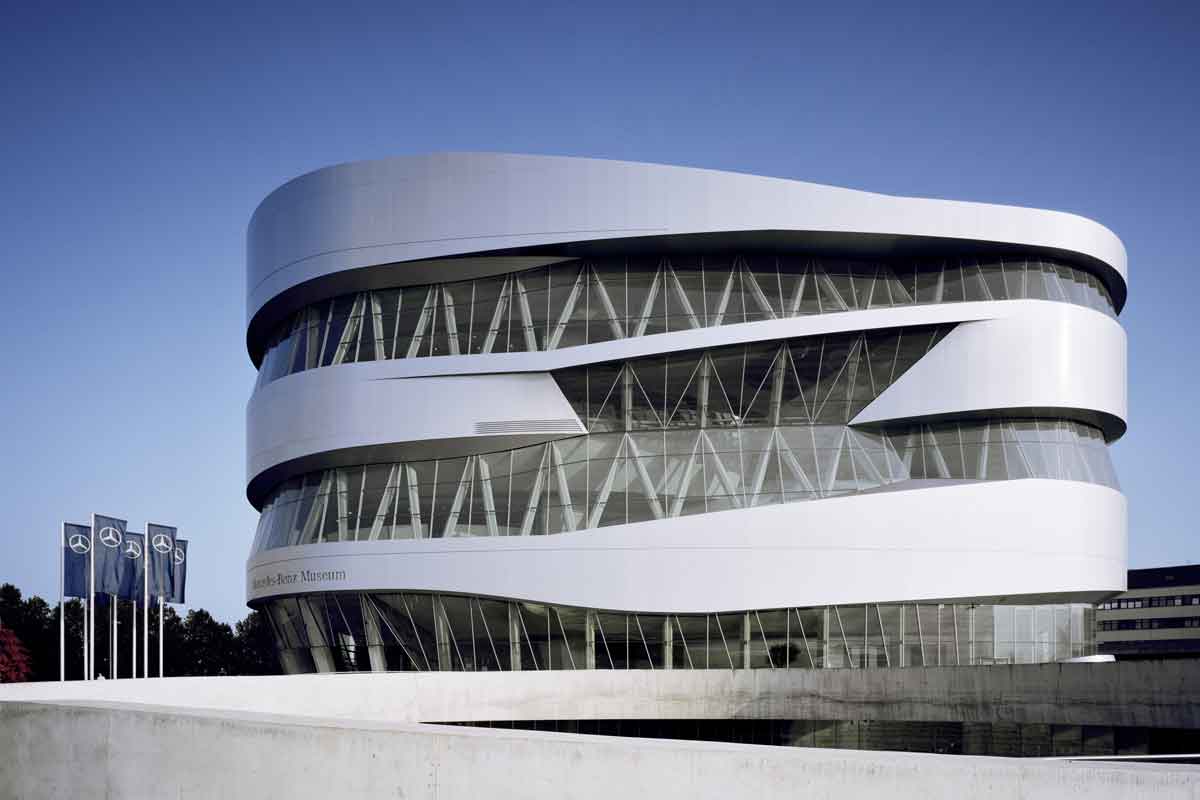The Mercedes-Benz Museum showcases more than 125 years of automotive history. 160 glittering, shiny vehicles compete on nine levels to stir the gasoline in your veins …in our case especially, because they let us take the first car ever made dating from 1886 for a test drive! But let’s take it one step at a time:
Opened in 2006 by Daimler Chrysler, the Mercedes-Benz Museum is a stand-out first because of its unusual architecture . Just like his client, the Dutch architect Ben van Berkel largely did away with corners and edges in building this double helix structure .
The museum’s shell is constructed mostly of materials the automotive industry also uses: glass and aluminum . The building succeeds with a convincing exterior and an interior that gets out of the way to let the cars be the show. No wonder then that it has been heaped with major architecture prizes…

© Daimler AG
Mercedes-Benz Museum – The fascination of technology
The starting point for viewing the car exhibition is actually on the eighth floor. You float up to those lofty heights in one of the eye catching retro-look lifts that let you glimpse the different epochs as you rise past the respective levels dedicated to them.
Wandering down the sloping circular ramp through the exhibitions is like taking a unique stroll through time as the automotive history of Mercedes-Benz unrolls, one legend after the other, all in chronological order!
Also a success is how the automotive history integrates with the historical context: Large format wall charts illustrate world events during a given era. It’s all here, the glamor and the glory, from the Beatles to Einstein.
Besides the previously mentioned legend rooms the exhibition is also split into collection spaces for thematically displaying the abundance and variety of vehicles bearing the Gottlieb Daimler and Carl Benz logos.
Walk down either double helix, or you end up in the exhibit “Silver arrows – Racing and Records“. Positioned on a banked curve are legendary record-breaking cars: the Phoenix race car, Lightning Benz, Silver Arrows, White Elephants (nickname given the super-heavy S-series race cars) all the way to Lewis Hamilton’s 2008 Formula 1 World Championship racer.
If you ever wondered, by the way, what the three points on the “Mercedes star” are all about: The three-pointed star symbolized Gottlieb Daimler‘s efforts toward universal motorization “on land, in water and in the air“.
And further, the brand can thank the daughter of the wily race car driver and Daimler dealer Emil Jellinek for the “Mercedes” name: It was he who prodded Daimler’s chief engineer Wilhelm Maybach (also have a familiar ring?) to build a race car instead of the then-typical “motorized horse buggies. “ That first “Mercedes“ with its robust 40 horsepower engine totally crushed the competition in the 1901 “Nizza (Nice) Racing Week“…
And just to conclude the story of the name: The engine and design pioneer Carl Benz was the leading car maker until about 1900, when Daimler overtook him; and then, in 1926, the two merged their companies into Daimler-Benz AG.
The Benz Patent Motor Car – the world’s first gasoline-powered automobile
And here we go: During our visit we agreed to the challenge of passing the driving test in the 1886 Benz Patent Motor Car… This “three wheeler” was the world’s very first gasoline car and represents the birth of the automobile!
Carl Benz designed his motor car with three wheels, because he was not happy with the steering systems that were standard in four-wheeled vehicles of the time. The double-pivot steering system that he developed and first patented seven years later is still in use today.
So that we would be allowed to drive this motorbike, which actually is a velocipede, we of course had to first pass a written test. That’s because driving such a legendary car – even one that only gets up to 12 mph – takes know-how!
After all, you need to know what to do if the 0.9 horsepower engine should overheat. Its impressive fuel economy of 10 liters of benzine (petroleum naphtha) and need for 100 liters of cooling water for each 100 kilometers driven does present some unusual challenges when all is said and done…
What a gas!
And here’s the proof: I am now one of the few to have driven the first car in the world!
(Post script for my environmentally conscious sister: No, I still don’t own a car!)
The Mercedes-Benz Nights of the Stars
Frankly, we didn’t travel to Stuttgart just for thrills in the curves, but for the gourmet Nights of the Stars, the latest edition of the exclusive Mercedes-Benz Nights of the Stars held from February 4- 9, 2014. Two times a year, Mercedes Benz transforms its car museum into a first-rate gourmet temple.
One top chef at a time hosts a culinary extravaganza on the top floor that silences any and all engine noise! We report on this “must try” experience with all the spicy details here .
You can find more images of the Mercedes-Benz Museum in our Flickr photo gallery:
[slickr-flickr search=sets set=”72157641002972784″ type=”gallery”]
Our thanks go to…
… Friederike Valet and Mareen Hoeppner with the Mercedes-Benz Museum for organizing our trip! We also extend warm thanks to Dietmar Gustke, Michaela Baumgarten, and Mark Scheerer for giving us the unique experience with the Benz three-wheeler! Our knees are still shaking ;-)
What stayed with us from the test drive as well as the museum tour during the Nights of the Stars: Staff members of the Mercedes-Benz Museum seem to have gasoline in their blood. With obvious passion and motoring proclivity these professionals know how to impart to their guests the enthusiasm they feel for “their” cars. Bravo, great job!
Many thanks also to Oliver Sefrin, head of Press and Public Relations in the German National Tourist Board (DZT) in Zurich und Sandra Nörpel of Stuttgart Marketing for the impeccable organization and support during this trip!